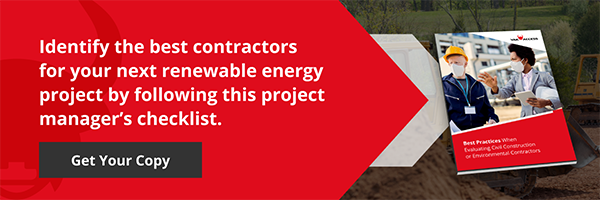The use of wind energy is on the rise both in the US and internationally, meaning there will be greater demand for supporting industries like access construction. Wind energy has the great benefit of relatively low maintenance, but you should not underestimate the initial work needed to install a wind farm. To transport wind turbines across the country, transfer them to their final destination, install the equipment, get the turbines online, and maintain them, you need the right teams with the right equipment and at the right time.
One key piece of the puzzle to keep in mind for your next wind energy project? Crane matting.
Want to learn more about how we help provide you the right equipment and at the right time? Check out our innovative YAK Crane mats.
How Cranes Are Used in Wind Energy Applications
Because wind turbines are so large and heavy, cranes must be used to assemble them onsite and maintain them after installation. Two types of heavy equipment—mobile cranes (with wheels) and crawler cranes (with tracks)—are typically used for wind energy applications.
Regardless of which type of crane is used, having a stable base and ample space to maneuver is critical for maintaining a safe work environment.
Wind Turbine Installation
Setting the stage for wind energy requires several steps at the site, including:
- Preparing the foundations.
- Digging trenches.
- Erecting towers and turbines.
- Installing electrical wiring.
- Connecting to the grid.
Wind turbines are often hundreds of feet high and weigh upwards of 200 tons, with individual elements weighing anywhere from a few tons to 70 tons each. With blades more than 170 feet long, it’s clear that cranes with the capacity to handle large, heavy components are necessary for a successful installation.
Wind Turbine Maintenance
Once installed, wind turbines must be maintained to keep them operating efficiently. This includes regular inspections, lubrication, cleaning, and repairs. Some of these maintenance activities can be performed by climbing the tower or using man lifts, but when blades or other major components need to be replaced, it’s a job for a crane.
How Cranes Stay Grounded
Lattice boom crawler cranes are the most common crane used for wind energy projects. As the name suggests, these cranes move around on tracks and have a boom that relies on a metal lattice structure to provide the stability and strength needed to move large, heavy loads.
Like most other types of cranes, this type of heavy machinery requires a ballast to keep it balanced and stable while lifting heavy loads. Depending on the terrain and other factors, various ballast systems might be used to keep cranes grounded and act as a counterweight. As the crane navigates the site and hoists components into the air, the ballast must be adjusted accordingly. In some cases, the ballast is on a mobile trailer or vehicle. In others, it must be moved by the crane itself.
Crane Matting with Wind Energy Applications
This movement of cranes and their ballast requires a stable work platform to maintain balance, ensure smooth transportation, and protect workers on the ground. Construction access mats, like YAK Crane mats, are often used to create temporary roads and stable work surfaces. However, a specialized type of mat is required when cranes are involved.
Crane matting is designed to handle the shifting weight of cranes and the heavy loads they carry. Using crane matting with outrigger mats prevents crane tip-overs, protects valuable equipment, and contributes to a safer work environment.
YAK ACCESS Crane Matting for Wind Energy Applications
YAK ACCESS provides crane matting, outrigger mats, and timber access mats for the renewable energy industry so you can access the site safely, protect your crew, and reduce your environmental impact.
But that’s not all we do. When you work with YAK ACCESS, you benefit from decades of experience in construction and utility site access. We’ll work closely with your team to determine the most efficient and cost-effective site access solutions so you can trim costs without compromising on safety.
Want to learn more about how we help you optimize project costs? Check out our innovative YAK Crane mats.


